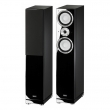Definitive Technology DR7 Bookshelf speakers
Definitive Technology's first loudspeakers were floor-standing bipolar designs (pairs of drivers on opposite sides of the cabinet, radiating in phase with each other to the front and rear). Later came the more conventional, less expensive DR7, also a floor-standing speaker but with just a single set of forward-firing drivers. Recently the company introduced a version of the DR7 suitable for shelf or stand mounting. Called the DR7 Bookshelf, it differs from the original (now known as the DR7 Tower) principally in height. The greater height of the 35-inch DR7 Tower gives it slightly deeper bass extension than the 22-inch DR7 Bookshelf.
The DR7 Bookshelf has a 6-inch woofer mounted midway up the front of its vented enclosure. The woofer has a mineral-filled polymer cone and a rugged cast-magnesium basket. It crosses over through a phase-coherent Linkwitz-Riley network to a 1-inch soft-dome tweeter with an aluminum voice coil and magnetic-fluid cooling.
The tweeter is located above the woofer and offset slightly to the right. The bass port is on the front panel, near the bottom.
Input binding posts, recessed into the back of the cabinet, accept single or dual banana plugs as well as stripped wire ends or lugs. The cabinet, which is heavily braced internally, is finished in black with what might be described as a generic woodgrain (the manufacturer describes it as "high-tech black"). The frame of the removable black cloth grille is designed to complement the speaker panel so as to minimize diffraction of sound from the cabinet edges.
Definitive Technology's specifications for the DR7 Bookshelf are minimal, but its frequency range is given as 26 Hz to 28 kHz, its sensitivity as 90 dB SPL (sound-pressure level) at 1 meter with an input of 2.83 volts, and its nominal impedance as "compatible with 8-ohm outputs." The DR7 is recommended for use with amplifiers rated between 20 and 200 watts per channel. It is available both separately and as part of Definitive Technology's new HT7 home theater package, which combines a pair of DR7 Bookshelfs with a tonally matched C1 jr. center-channel speaker and a pair of BP1 bipolar surround speakers for just over $1,000 total.
We mounted the DR7's on stands, weighted with sand, that placed the tops of the cabinets 35 inches from the floor. They were positioned 6 feet apart and 18 inches from the wall behind them, angled slightly toward the center of the room.
The averaged room response of the two speakers was quite uniform, within +/-3 dB from 300 Hz to 20 kHz. Quasi-anechoic MLS response measurements confirmed this result, showing a mere +/-2-dB deviation in the on-axis response over the same range. The close-miked bass response peaked at 70 Hz, falling off at 12dB per octave at lower frequencies and sloping down slightly above 70 Hz. The composite frequency response was +/-5 dB from 38 Hz to 20 kHz. High-frequency dispersion was typical of 1-inch dome drivers, with the output 45 degrees off-axis falling by 2 dB at 6 kHz, 5 dB at 10 kHz, and 13 dB at 20 kHz.
Group-delay measurements indicated that the crossover was at about 2 kHz. The group delay varied only about 100 microseconds overall from 4 to 20 kHz and less than 2 milliseconds from the lower woofer range through the crossover to the tweeter.
The system impedance reached a minimum of 3.8 ohms at 170 Hz. There were two bass peaks, 14 ohms at 25 Hz and 11.5 ohms at 75 Hz, and the maximum reading was 20 ohms at 13 Hz. Sensitivity was 90 dB, as rated, and at that level woofer distortion was between 0.5 and 1 percent from 2 kHz down to 70 Hz. It rose at lower frequencies to 4.5 percent at 40 Hz, approximately the useful lower limit of the speaker's response. Our singlecycle tone-burst tests showed that the DR7 can handle high input levels without excessive distortion. At middle and high frequencies, it withstood the maximum power our amplifier could deliver-410 watts at 1 kHz and 670 watts at 10 kHz-without distress. At 100 Hz, the speaker began to sound hard at 185 watts input.
The DR7 Bookshelf sounded as good as it measured and clearly was well ahead of most similarly priced speakers we have tested in all the important subjective characteristics-frequency extension in both treble and bass, tonal balance, and imaging (which I use in the sense of simulating the effect of a seamless soundstage between the speakers and a little beyond them, with a sense of depth).
When compared with a number of substantially more expensive speakers, the DR7 not only was a peer of any of them, but in numerous A/B comparisons it usually outperformed speakers priced as much as two or three times higher. Even a pair of well-known British speakers, comparable to the DR7 in size and driver complement but originally (some years ago) selling at more than three times its price, and which I had always considered to have superior imaging qualities, came off a poor second to these remarkable speakers.
Of course, individual judgments of speaker quality are always affected by the local acoustic environment and the specific program material, to say nothing of the listener's personal taste. Depending on all the above and more, the Definitive Technology DR7 Bookshelf may or may not be the "best" speaker (whatever that means) of its size or configuration. But as far as I am concerned, it is the best-sounding speaker that I have heard in my home selling at anywhere near its price. It is a remarkable value no matter how you define that term.




